Featured Application
Organic waste can provide an alternative to synthetic fertilizers, maintaining productivity with limited environmental impact. This research evaluates the potential use of processed animal waste in corn fertilization, which may represent a partially closed nutrient cycle of importance in a sustainable agricultural system. It also assesses the potential use of meat and bone meal derived from animal by-products in crop production, not only as a source of nutrients to improve soil nutrient abundance but also as a source of continued soil contamination by organochlorine pesticide residues.
Abstract
Despite the fact that organochlorine pesticides (OCPs) were banned many years ago, their residues are still present in the natural environment and pose a potential health risk to humans and animals. This study was undertaken to evaluate the effect of meat and bone meal (1.0, 2.0 and 3.0 t ha−1 MBM) derived from animal by-products and used as fertilizer on the content of γ-HCH (γ-hexachlorocyclohexane), DDT (1,1,1-Trichloro-bis-2,2 [4-chlorophenyl]-ethane) and its metabolites (DDD, dichlorodiphenyldichloroethane and DDE, dichlorodiphenyldichloroethylene) in MBM, soil, and maize grain. A long-term small-area field experiment with MBM applied to maize grown in monoculture was conducted at the Agricultural Experiment Station in Tomaszkowo, Poland (53°71′ N, 20°43′ E) from 2014 to 2017. The concentration of γ-HCH in soil decreased gradually, whereas the levels of DDT and its metabolites continued to increase in successive years of the experiment. A minor increase in DDT accumulation in maize grain was also observed, particularly in treatments supplied with mineral fertilizers. Meat and bone meal affected grain contamination levels, and the highest MBM rates decreased the content of DDT metabolites in grain. The results of the study suggest that MBM could be a secondary source of OCPs in the agricultural environment and that their availability to plants varies depending on soil parameters and weather conditions.
1. Introduction
Organochlorine pesticides (OCPs) are ubiquitous, resistant, and persistent compounds, and one of the key sources of pollution that contribute to environmental degradation and pose a potential health risk to humans and animals [1,2]. For many decades, OCPs were used to control pests and pathogens in agricultural production [3,4]. Due to their negative impact on the environment and human health, OCPs were banned by the Stockholm Convention on Persistent Organic Pollutants, an international environmental treaty signed in 2001 [5]. Despite this ban, OCP residues are still identified in various environments, food products, and in human and animal bodies [6,7,8]. Organochlorine pesticides are characterized by low selectivity and exert toxic effects not only on target pests, but also on non-target animal species and humans [9,10]. These compounds are harmful not only to the individuals who are directly exposed, but also to consumers of contaminated food [11,12,13]. The uptake of contaminants by plants is often the first step in the process of their accumulation in human and animal food chains [7,14,15].
Organochlorine pesticides contain the active ingredients 1,1,1-Trichloro-bis-2,2 [4-chlorophenyl]-ethane (DDT, sold under the Azotox trademark in Poland) and γ-hexachlorocyclohexane (γ-HCH, lindane) [16]. In Poland, the use of pesticides containing DDT and γ-HCH was banned in 1976 and 1988, respectively. Residues of DDT, its metabolites (dichlorodiphenyldichloroethylene, DDE, and dichlorodiphenyldichloroethane, DDD), and γ-HCH are still present in soil and can be assimilated by crop plants. These residues have been identified in many plant- and animal-based foods [11,17,18]. Organochlorine pesticides are highly resistant to environmental degradation [19,20]. These organic pollutants are highly persistent in the natural environment, and their half-life in soils can last up to several decades [21]. Pesticide contamination reduces both the biodiversity and functions of soil-dwelling microorganisms [22,23], which slows down the degradation of residual pollutants. The accumulation of OCPs in the soil environment can be attributed to both point source pollution (industrial emissions, processed waste, and wastewater) and non-point source pollution (wind and precipitation), where the latter plays the key role in transporting these contaminants over long distances [24,25].
Numerous environmental factors (soil quality, history of pesticide use, climate) can contribute to the persistence or degradation of OCP residues [4,26,27]. Remediation treatments aiming to improve soil properties through the addition of soil amendments such as organic matter considerably retard the biodegradation of OCPs because these compounds bind to dissolved organic carbon [28]. Soils abundant in organic matter absorb more organic pollutants because hydrophobic compounds have affinity for selected organic matter fractions [29,30]. Organochlorine pesticides are compounds with very high adsorption coefficients, which implies that they can be strongly bound to soil particles [23].
Prolonged exposure to OCPs leads to their bioaccumulation in food chains [3,7,31]. Their residues can be transferred to livestock through contaminated feed or pesticides used to control external parasites [32,33]. Organochlorine pesticides are lipophilic, and they can accumulate in the adipose tissue of animals [31]. Elevated concentrations of these toxic compounds have been found in organs such as the liver and the kidneys. As a rich source of nutrients, meat and bone meal (MBM) derived from slaughterhouse waste is used as fertilizer [34,35,36] or feed [37], thus contributing to the spread of organochlorine contaminants in the agricultural environment [38]. Our research evaluates the potential use of meat and bone meal derived from animal by-products in crop production, not only as a source of nutrients to improve soil fertility, but also as a potential source of continued soil contamination by organochlorine pesticide residues.
A research hypothesis was formulated as follows: The use of MBM in maize cultivation increases the content of chlorinated organic pollutants in the soil and maize grain. The aim of this study is to determine the residual levels of OCPs (γ-HCH, DDT, and their metabolites) in MBM, soil, and maize grain, as a direct effect of the use of animal waste as fertilizer.
2. The Materials and Methods
2.1. Site and Experimental Design
A long-term small-area field experiment with MBM applied to maize was conducted at the Agricultural Experiment Station in Tomaszkowo, Poland (53°71′ N, 20° 43′ E) in 2014–2017. The experiment had a randomized block design with four replications. The soil was classified as Haplic Luvisol Loamic (HLL) [34]. The soil contained 10.1 g kg−1 organic matter, 0.55 g kg−1 total N, 0.33 g kg−1 P, 1.33 g kg−1 K, and soil pH in 1M KCl was 4.89.
Maize was sown in experimental plots with an area of 15 m2 (3.00 m × 5 m) and a harvested area of 11.25 m2 each (2.25 m × 5 m), with 0.75 m inter-row spacing and a plant density of 8 plants m−2. Maize was grown in a four-year monoculture, and winter triticale was sown in 2013 as the preceding crop. Winter triticale was harvested on 15 August 2013, and the field was plowed. In each year of the study, shallow tillage treatments were applied before spring sowing to incorporate mineral fertilizers and MBM into the soil. After maize harvest, the plots were tilled with a disc cultivator, harrowed, and deep plowed before the winter in all experimental years. The plots were sown with MAS 15P maize (FAO 200 maturity group; supplied by Maisadour (Haut-Mauco, France)). The yield performance of this early, single-cross hybrid cultivar was estimated at 102% relative to the reference. Weeds were controlled with Lumax 537.5 SE herbicide at 4.0 L ha−1 (active ingredients: mesotrione 37.5 g dm−3, s-metolachlor—312.5 g dm−3, terbuthylazine—187.5 g dm−3). Seeds were dressed with Mesurol 537.5 SE (methiocarb—500 g dm−3) at 1 L per 100 kg of seeds to control pathogens. Chemical pesticides were not applied.
Maize was fertilized with MBM supplied by an animal by-products disposal plant (SARIA Poland Ltd., Długi Borek, Poland). Meat and bone meal was applied at increasing rates of 1.0, 2.0, and 3.0 t ha−1 (Table 1). The chemical composition of MBM (90% dry matter content) was as follows: 66.9 g C kg−1; 6.10 g N kg−1; 3.10 g P kg−1; 0.40 g K kg−1; 8.85 g Ca kg−1; 0.30 g Mg kg−1; 8.0 mg Cu g−1, 1189 mg Fe g−1; 86.5 mg Zn g−1, and 29.0 mg Mn g−1. Meat and bone meal was applied before sowing. Two control treatments were established (without fertilization and with mineral NPK fertilization). In the NPK treatment, mineral fertilizers containing nitrogen (urea, 46% N), phosphorus (triple superphosphate, 40.0% P), and potassium (potash salt, 49.8% K) were incorporated into the soil.

Table 1.
The amount of organic matter (Corganic) and macronutrients introduced to soil with fertilizers (mean of 2014–2017, kg ha−1).
2.2. Plant Growth and Weather Conditions
Weather conditions, including temperature and precipitation, affect the decomposition of soil organic matter, the main adsorbent of OCPs [39]. In 2014, 2015, and 2016, higher temperatures during the growing season (particularly in June and July) could have enhanced biological processes in soil, thus influencing the degradation rates of MBM and organic matter (Figure 1). However, in 2014 and 2015, a water deficit in June and July (when the growth and development of maize is accelerated) could have slowed the absorption of nutrients released from soil organic matter and introduced with MBM (Figure 2). In 2017, low temperatures in April and May, as well as low precipitation in May, could have inhibited the mineralization process at the beginning of the season, thus reducing nutrient availability in the early stages of maize growth. High precipitation in 2017, particularly in July and September, could have caused nutrients such as nitrogen to leach downward into the soil profile and groundwater, slowing the decomposition of soil organic matter and the inactivation of pesticide residues [40,41].
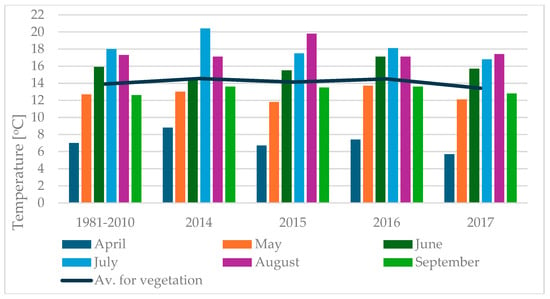
Figure 1.
Monthly temperature [°C] in the growing seasons of 2014–2017 relative to the long-term average (1981–2010).
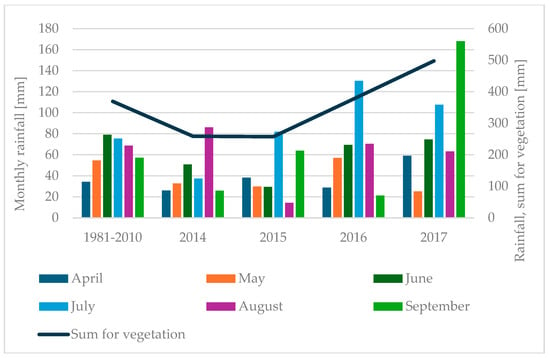
Figure 2.
Monthly rainfall [mm] in the growing seasons of 2014–2017 relative to the long-term average (1981–2010).
2.3. Determination of Grain Yield and Grain Lipid Content
Maize ears were harvested manually in the fully-ripe stage (BBCH 90), and two outer rows were left in the field. Maize was threshed with a plot combine harvester (Wintersteiger Classic 1540, Ried im Innkreis, Austria). The moisture content of grain was determined with a GMS v2 moisture meter (Dramiński, Gietrzwałd, Poland). Grain yield was determined at a moisture content of 15%. Lipid extraction was carried out by the extraction method according to Weibull–Stoldt [42] using concentrated hydrochloric acid (HCl) and a mixture of organic solvents: petroleum ether and ethyl ether in a 50:50 ratio.
2.4. Determination of Organic Pollutants in Meat and Bone Meal, Soil, and Grain
Preparation of extracts for the determination of organochlorine compounds was carried out by the method according to Ludwicki et al. [43]. The method involves the lipid degradation during extraction with concentrated sulfuric acid and the release of the tested compounds into the hexane layer. Determination of γ-HCH, as well as DDT and its metabolites DDE and DDD, was carried out by gas chromatography using an Agilent Technologies 6890N gas chromatograph. This device was equipped with an electron capture detector (ECD), so it was possible to identify and quantify organochlorine compounds in the test material. The gas chromatograph was equipped with a capillary column (25 m × 0.32 mm) filled with DB-1701 P liquid phase, and the film thickness was 0.25 μm. The applied temperatures in the dispenser, detector, and column were, respectively, 250 °C, 280 °C, and 200 °C. Helium was used as the carrier gas, supplied at a flow rate of 2.5 cm3/min. Recovery rates were 90% for γ-HCH, while DDT, DDE, and DDD were 96%, 97%, and 93%, respectively. The concentration of residual organochlorine insecticides in the sample was calculated by comparing the peak areas of the samples tested with those of the standard used, using Unicam 4880 computer software. The separation was carried out based on reference material (Supelco—Pesticide Std. Mix A-1; B-1, Cat. No. 47977; 47978). The results obtained are presented as average values from three parallel determinations, expressed in μg kg−1 lipid.
2.5. Determination of Soil Organic Carbon
The content of Corg in soil was determined by Tiurin’s method using 0.4 N potassium dichromate (K2Cr2O7) solution as the oxidizing agent, sulfuric (VI) acid (H2SO4), and silver (I) sulfate (Ag2SO4) as the catalyst, and it was quantified with a spectrophotometer [44].
2.6. Statistical Analysis
The results of the experiment were processed by computing basic statistics, and differences between group means were determined by two-way analysis of variance (ANOVA). Homogeneous groups were identified using Tukey’s test (p ≤ 0.5). The effect of fertilization treatments on the concentrations of γ-HCH, DDT, and its metabolites (DDD and DDE) in soil and maize grain was determined by principal component analysis (PCA). Statistical analyses were conducted in the Statistica PL v. 13.3 (TIBCO, Krakow, Poland) program at a significance level of α = 0.05.
3. Results and Discussion
3.1. Residual Levels of Organochlorine Pesticides in Meat and Bone Meal
Minor differences in the residual levels of OCPs in MBM were observed across the experimental years (Figure 3).
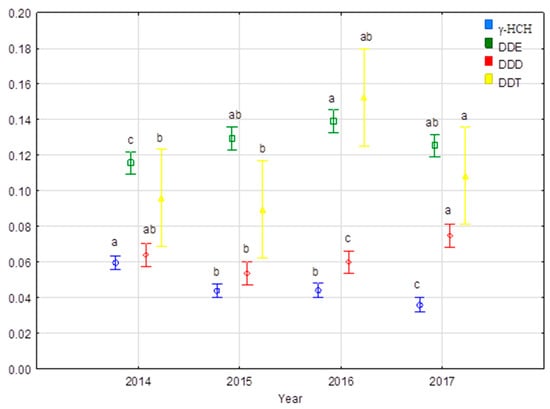
Figure 3.
Residual levels of organochlorine pesticides in meat and bone meal (MBM). Values followed by the same letters do not differ significantly in Tukey’s (HSD) test (p < 0.05). γ-HCH—γ-hexachlorocyclohexane, DDT—1,1,1-Trichloro-bis-2,2 [4-chlorophenyl]-ethane, DDD—dichlorodiphenyldichloroethane, DDE—dichlorodiphenyldichloroethylene.
3.2. Soil Organic Carbon (Corg)
Organic matter is an important soil component that affects the degradation or persistence of OCPs [45,46]. The content of soil organic carbon was lower in 2016 and 2017 (Table 2). This parameter decreased gradually in successive years of the experiment, particularly in unfertilized treatments, NPK treatments, and 1.0 t ha−1 MBM treatments. The treatments fertilized with MBM at 2.0 and 3.0 t ha−1 were characterized by the highest organic matter content, high grain yields, and, consequently, stable Corg levels during the experiment. According to Piash et al. [36], MBM derived from meat processing waste and used as fertilizer is a rich source of nutrients for recycling and organic carbon in crop production.

Table 2.
Soil organic carbon (Corg) content, g kg−1 (mean value and standard error).
3.3. Residual Levels of Organochlorine Pesticides in Soil
Organochlorine pesticides are accumulated mainly in soil [18,47,48], and their absorption is largely determined by the content of soil organic matter [46,49]. An analysis of OCP residues revealed the highest average levels of DDT (1.14 μg kg−1) (Figure 4a) and lower levels of γ-HCH (0.33 μg kg−1). Similar proportions of soil contaminants were reported by Maliszewska–Kurdybach et al. [6]. In the cited study, DDT was also the most prevalent pollutant (accounting for 83% of all soil contaminants), which was attributed to its higher persistence as well as the fact that this pesticide had been more widely applied than lindane in Poland. Soil γ-HCH levels decreased gradually in all treatments. In 2017, they were reduced by 69% relative to those noted in 2014 (Figure 4a). The concentration of DDT continued to increase up to the third year of the study (by 60.1% on average in 2016 relative to 2014). In the present study, DDE concentration in soil was higher than DDD concentration. Similar observations were made by Tsiantas et al. [50]. The authors concluded that DDT is most likely converted to DDE through the aerobic degradation pathway. In the analyzed soil, DDE concentration was highest in the third year (1.037 μg kg−1), and DDD concentration was highest in the fourth year of the study (0.061 μg kg−1) (Figure 4a).
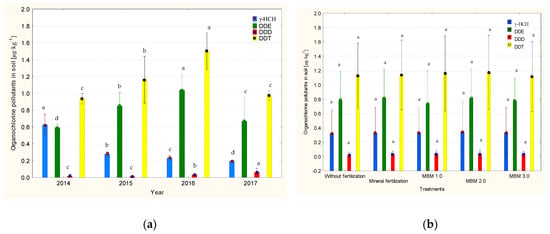
Figure 4.
Residual levels of organochlorine pesticides in soil, μg kg−1. (a) average for year, (b) average for treatment, %. Values followed by the same letters do not differ significantly in Tukey’s (HSD) test (p < 0.05). γ-HCH—γ-hexachlorocyclohexane, DDT—1,1,1-Trichloro-bis-2,2 [4-chlorophenyl]-ethane, DDD—dichlorodiphenyldichloroethane, DDE—dichlorodiphenyldichloroethylene.
None of the analyzed fertilization treatments significantly influenced soil γ-HCH levels (Figure 4b). An analysis of the interaction between fertilization treatments and years of the study revealed similar relationships (Figure 5a–d). Fertilization treatments had no significant effect on soil DDT levels, either in terms of average values (Figure 4b) or in experimental years (Figure 5). Similarly to DDT levels, the concentrations of DDT metabolites (DDD and DDE) in soil were not significantly affected by fertilization treatments in the experimental years (Figure 4b) or in terms of average values (Figure 5). The exception was the significantly lower DDD content in the no-fertilization treatment in 2017, compared to the other treatments. Soil γ-HCH levels are affected by environmental processes such as plant metabolism, mineralization, photodegradation, and potential translocation to groundwater [50]. These processes contribute to the more rapid degradation of γ-HCH than other organochlorine contaminants in soil. Despite the above, OCPs are still characterized by high bioaccumulation potential and remain strongly adsorbed by organic matter particles [49,51]. The concentrations of OCPs are higher in surface soil layers, probably because these contaminants are effectively transported and deposited by wind and precipitation [52]. The concentrations of pesticide residues tend to be higher in soils abundant in Corg [53]. However, higher Corg levels stimulate the activity of soil-dwelling microorganisms that degrade OCPs [54]. Soil microorganisms decompose DDT more rapidly than its metabolites, DDE and DDD. However, the degradation rate is generally slow, and it is affected by many factors, including soil type, temperature, moisture content, and the content of Corg in soil [55,56].
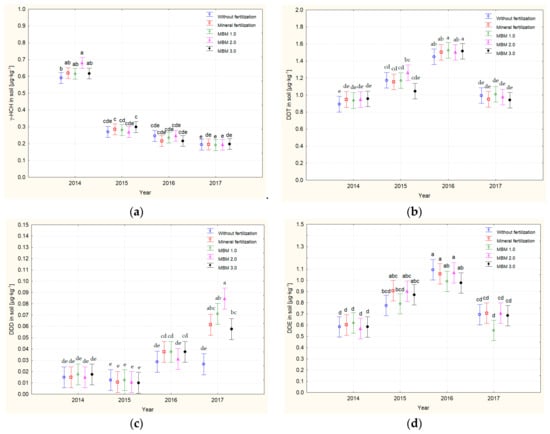
Figure 5.
Residual levels of organochlorine pesticides in soil, μg kg−1, interactions between years and treatments. (a) content of γ-HCH, (b) content of DDT, (c) content of DDD, (d) content of DDE. Values followed by the same letters do not differ significantly in Tukey’s (HSD) test (p < 0.05). γ-HCH—γ-hexachlorocyclohexane, DDT—1,1,1-Trichloro-bis-2,2 [4-chlorophenyl]-ethane, DDD—dichlorodiphenyldichloroethane, DDE—dichlorodiphenyldichloroethylene.
3.4. Grain Yield and Grain Lipid Content
Grain yield peaked in 2016, when it was 57.9% higher than in the first year of the study (Table 3). This result was attributed to favorable temperature (especially in July) and precipitation, which promoted the mineralization of soil organic matter and increased the availability of nutrients for maize plants. In all years, the average grain yield was highest in mineral NPK treatments. The supply of nutrients, especially in organic form, should be accompanied by favorable weather conditions that stimulate the activity of microorganisms responsible for their mineralization [56,57,58,59]. In 2015, low grain yields were accompanied by a low lipid content in maize grain, which was attributed to weather conditions (low precipitation levels) that inhibited plant growth. Higher rates of MBM (2.0 and 3.0 t ha−1) contributed to lipid content in maize grain.

Table 3.
Grain yield (t ha−1) and lipid content (%) of maize grain (mean value and standard error).
3.5. Residual Levels of Organochlorine Pesticides in Grain
Agricultural crops such as cereals, fruit, and vegetables are often contaminated with residues of persistent pesticides [14,17,60]. The highest average content of γ HCH in maize grain was noted in 2016 (Figure 6a). During the experiment, grain contamination with pesticide residues containing DDT increased by 20.8–30.1% relative to the first year. However, the content of DDT metabolites in maize grain differed across years. DDE, a secondary metabolite of DDT, can be further degraded to DDD [61]. Differences in the extent of plant uptake of persistent organic pollutants can be attributed mainly to the hydrophobicity of these chemicals [51]. The concentration of DDD in maize grain was higher than the concentration of DDE.
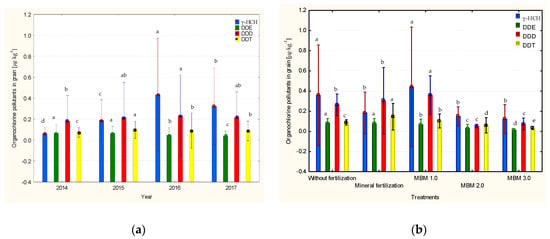
Figure 6.
Residual levels of organochlorine pesticides in maize grain, μg kg−1. (a) average for year, (b) average for treatment, %. Values followed by the same letters do not differ significantly in Tukey’s (HSD) test (p < 0.05). γ-HCH—γ-hexachlorocyclohexane, DDT—1,1,1-Trichloro-bis-2,2 [4-chlorophenyl]-ethane, DDD—dichlorodiphenyldichloroethane, DDE—dichlorodiphenyldichloroethylene.
The concentration of γ-HCH in maize grain was significantly highest in unfertilized treatments and 1.0 t ha−1 MBM treatments (Figure 6b). Grain γ-HCH levels were lowest in 2014 in all fertilization treatments (Figure 7a). This result was influenced by the γ-HCH content of grain in unfertilized treatments in 2015 and 2016 and in 1.0 t ha−1 MBM treatments in 2016 and 2017.
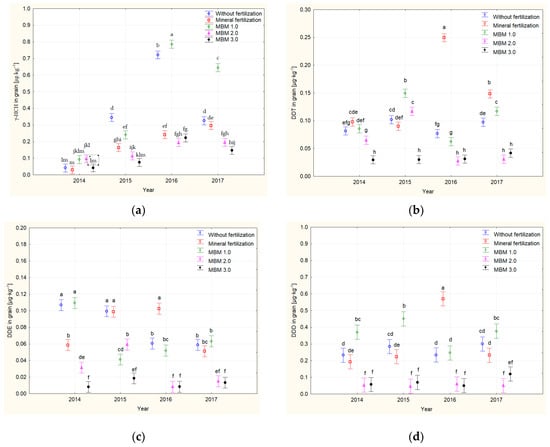
Figure 7.
Residual levels of organochlorine pesticides in maize grain, μg kg−1: interactions between years and treatments. (a) content of γ-HCH, (b) content of DDT, (c) content of DDD, (d) content of DDE. Values followed by the same letters do not differ significantly in Tukey’s (HSD) test (p < 0.05). γ-HCH—γ-hexachlorocyclohexane, DDT—1,1,1-Trichloro-bis-2,2 [4-chlorophenyl]-ethane, DDD—dichlorodiphenyldichloroethane, DDE—dichlorodiphenyldichloroethylene.
The DDT content of grain (Figure 6b) increased gradually in successive years with increasing soil DDT (Figure 5b). There is a close relationship between the residual levels of OCPs in soil and plants, and the rate of OCP uptake by plants is determined by the concentrations of these contaminants in soil [7,14,48,60]. DDT levels in maize grain were highest in NPK treatments, mostly due to high DDT levels in 2016 and 2017 (Figure 7b).
The content of DDE in maize grain was highest in unfertilized treatments and NPK treatments, whereas DDD levels were highest in 1.0 t ha−1 MBM treatments (Figure 6b). On average, the lowest DDD and DDE concentrations in maize grain were noted in treatments fertilized with the highest MBM rates (2.0 and 3.0 t ha−1). The only exception was higher DDE concentration in grain in 2.0 MBM t ha−1 treatments than in 1.0 MBM t ha−1 treatments. The average levels of DDT metabolites (DDD and DDE) in maize grain over the years of the study did not always correspond to the values noted in fertilization treatments (Figure 7a,b). The lower levels of organochlorine pesticide residues in maize grain harvested from plots fertilized with higher doses of organic matter in the form of MBM (2.0 and 3.0 t ha−1) were the result of improved physico-chemical soil properties, which enabled the plants to activate defense mechanisms against contaminants [34,51]. MBM introduces into the soil a complex of mineral nutrients available to plants [36,62,63], and well-nourished maize plants are better able to cope with harmful factors by deactivating them through physiological processes [64].
Despite the fact that OCPs were detected in maize grain, their concentrations did not exceed the maximum residue levels. In Commission Regulation No. 149/2008 [65], the maximum residue levels of OCPs in cereal grain were set at 10 µg kg−1 for γ-HCH and 50 μg kg−1 for ƩDDT.
3.6. Principal Component Analysis (PCA)
The results of the principal component analysis (Figure 8) indicated that the first two principal components explained 58.76% (PC1) and 33.02% (PC2) of the variance, respectively, accounting for a total of 91.78% of the variance in the original variables. The vectors representing the original variables extend nearly to the edges of the unit circle, suggesting that the two components provide an excellent representation of the variable space (Figure 8a). Soil contaminants (DDT, DDE, DDD, γ-HCH) are distributed in different parts of the PCA plot, which suggests that they have varied impacts on the environment. The concentration of γ-HCH was positively correlated with soil Corg content. γ-HCH can bind to soil organic matter, but it can also be gradually released from soil [60]. No significant correlations were noted between Corg content and the levels of DDT, DDE, and DDD in soil. According to Zhang et al. [55] and Qu et al. [66], the presence of a positive correlation between DDT concentration and total Corg content indicates that DDT follows a secondary distribution pattern. DDT and its derivatives are hydrophobic compounds that tend to accumulate in soil organic matter [23].
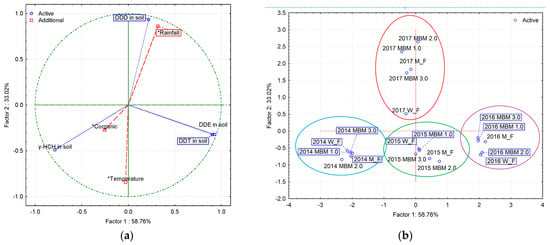
Figure 8.
Results of PCA exploring the effect of temperature, precipitation, and Corg content on the residual levels of organochlorine pesticides in soil. (a) projection of variables and treatments onto the first and second principal components, (b) γ-HCH—γ-hexachlorocyclohexane, DDT—1,1,1-Trichloro-bis-2,2 [4-chlorophenyl]-ethane, DDD—dichlorodiphenyldichloroethane, DDE—dichlorodiphenyldichloroethylene.
In the current study, rainfall was negatively correlated with soil DDD levels, which could suggest that these compounds were leached from soil or degraded. A positive correlation was observed between temperature and the presence of γ-HCH in soil. Zhang et al. [53] argued that low soil γ-HCH levels could indicate that this contaminant is volatilized under the influence of higher temperatures. The points presented in Figure 8b correspond to individual fertilizer treatment cases in specific cultivation years. The distances between the points indicate the degree of similarity between the cultivation practices across different years. Based on the data presented in Figure 8b, soil contaminants were divided into four groups corresponding to the experimental years. The results noted in 2017 clearly differed from the data recorded in other years, which suggests that OCP concentrations were influenced by weather conditions (temperature and precipitation), fertilization, and the gradual accumulation of fertilizers in successive years of the study. In the analysis of the effects of temperature, rainfall, grain yield, and lipid content on the concentration of organochlorine pesticide residues in the grain, PCA revealed that PC1 and PC2 accounted for 61.94% and 24.18% of the variance, respectively, representing 86.12% of the total variance in the original dataset.
The concentration of γ-HCH in grain was positively correlated with precipitation, but not with temperature (Figure 9a). According to Ding et al. [67], the lipid of γ-HCH in soil is determined by weather conditions, and γ-HCH levels decrease with a drop in temperature and increase in response to abundant rainfall. In this study, the content of DDT and its metabolites in grain was not correlated with precipitation levels in the growing seasons. Grain lipid content was negatively correlated with organochlorine contamination. The accumulation of OCPs in plants is determined by the chemical structure of these compounds as well as plant physiology [21]. Residual pesticides are taken up mainly by roots and absorbed by lipophilic tissues in plants [18].
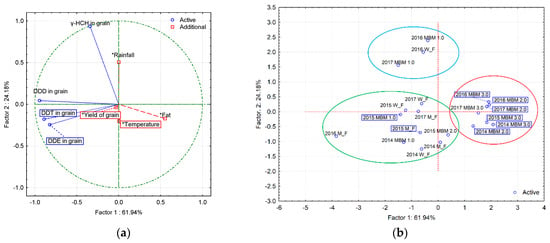
Figure 9.
Results of PCA exploring the effect of temperature, precipitation, grain yield, and grain lipid content on the residual levels of organochlorine pesticides in grain. (a) projection of variables and treatments onto the first and second principal components, (b) γ-HCH—γ-hexachlorocyclohexane, DDT—1,1,1-Trichloro-bis-2,2 [4-chlorophenyl]-ethane, DDD—dichlorodiphenyldichloroethane, DDE—dichlorodiphenyldichloroethylene.
In the PCA, the residual levels of OCPs (γ-HCH, DDT, and their metabolites) in maize grain formed three groups based on fertilization treatments and years of the study (Figure 9b). The content of OCPs in grain was similar in treatments fertilized with MBM at 2.0 t ha−1 and 3.0 t ha−1, regardless of year. These treatments were characterized by the highest supply of nutrients and the highest grain yield. Mitton et al. [68] found that soil DDT levels are influenced by plant growth rates, which stimulate microbial activity and affect the availability of residual pesticides. In the present study, three treatments with similar grain contamination levels, i.e., the unfertilized treatment (2016) and 1.0 t ha−1 MBM treatments (2016 and 2017), formed the smallest group. Similarly, in the analysis of organochlorine contaminant concentrations in MBM and soil, the first two components explained 57.94% (PC1) and 27.23% (PC2) of the variance, again totaling 86.12% of the total variance. The residual levels of DDT, its metabolites (DDE and DDD), and γ-HCH in MBM were positively correlated with DDE concentration in soil. The levels of DDT and its metabolites (DDE and DDD) in MBM were negatively correlated with the concentrations of DDT and DDD in soil. The concentration of γ-HCH in MBM was positively correlated with γ-HCH levels in soil and negatively correlated with DDT and DDD levels in soil (Figure 10a).
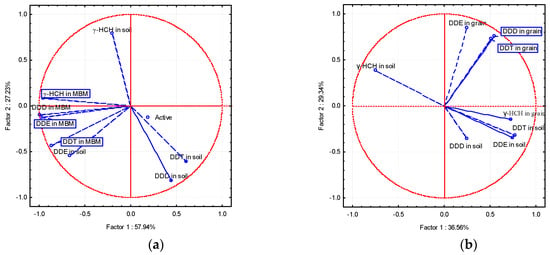
Figure 10.
Results of PCA exploring the effect of the residual levels of organochlorine pesticides in meat and bone meal (MBM) on the residual levels of organochlorine pesticides in soil. (a) effect of the residual levels of organochlorine pesticides in soil on the residual levels of organochlorine pesticides in grain, (b) γ-HCH—γ-hexachlorocyclohexane, DDT—1,1,1-Trichloro-bis-2,2 [4-chlorophenyl]-ethane, DDD—dichlorodiphenyldichloroethane, DDE—dichlorodiphenyldichloroethylene.
When examining the influence of organochlorine contamination in both soil and grain, PCA results showed that the first two components explained 65.9% of the total variance, with 36.56% attributed to PC1 and 29.34% to PC2. Soil contamination with DDT, DDE, and DDD was positively correlated with the content of γ-HCH in grain (Figure 10b). A negative correlation was found between γ-HCH concentrations in soil and grain. Li et al. [69] suggested that the rate of DDT absorption by plants was determined by DDT concentration in soil. They reported a weaker correlation between the residual levels of γ-HCH in soil and plant tissues.
4. Conclusions
Organochlorine pesticide residues were identified in MBM, soil, and maize grain, which suggests that these persistent contaminants follow a secondary distribution pattern. The organic substances introduced into the soil with MBM could affect the sorption and bioavailability of contaminants. Higher MBM rates stabilized the content of organic carbon in soil, but did not eliminate pesticides. The concentration of γ-HCH decreased gradually in successive years of the experiment, whereas DDT and its metabolites were accumulated in soil and maize grain. γ-HCH concentration was positively correlated with precipitation, suggesting that rainfall may affect its degradation and uptake. The study demonstrated that the residual levels of OCPs should be monitored in agricultural products, particularly in crops fertilized with animal by-products that can act as a secondary source of contamination. Given the proven potential for airborne translocation, the variable composition of organic waste, and the influence of weather conditions on the biological and physico-chemical properties of soil, which significantly affect the persistence of organochlorine pesticides, the conclusions of this study should be interpreted in the context of the prevailing conditions in a given area.
Author Contributions
Conceptualization, A.S.; methodology, A.S., E.K. and R.P.-F.; validation, A.S., K.W. and E.K.; formal analysis, A.S., K.W. and E.K.; investigation, A.S. and R.P.-F.; resources, A.S. and R.P.-F.; writing—original draft preparation, A.S., K.W. and E.K.; writing—review and editing, A.S. and K.W.; visualization, A.S. and E.K.; supervision, A.S. and K.W.; project administration, A.S.; funding acquisition, A.S., K.W., E.K. and R.P.-F. All authors have read and agreed to the published version of the manuscript.
Funding
The results presented in this paper were obtained as part of a comprehensive study financed by the University of Warmia and Mazury in Olsztyn, Faculty of Agriculture and Forestry, Department of Agroecosystems and Horticulture (grant N 30.610.015–110).
Institutional Review Board Statement
Not applicable.
Informed Consent Statement
Not applicable.
Data Availability Statement
The datasets used and/or analyzed during the current study are available from the corresponding author on reasonable request.
Conflicts of Interest
The authors declare no conflict of interest. The funders had no role in the design of the study; in the collection, analyses, or interpretation of data; in the writing of the manuscript; or in the decision to publish the results.
References
- Kalyabina, V.P.; Esimbekova, E.N.; Kopylova, K.V.; Kratasyuk, V.A. Pesticides: Formulants, distribution pathways and effects on human health—A review. Toxicol. Rep. 2021, 8, 1179–1192. [Google Scholar] [CrossRef] [PubMed]
- Kamalesh, T.; Kumar, P.S.; Rangasamy, G. An insights of organochlorine pesticides categories, properties, eco-toxicity and new developments in bioremediation process. Environ. Pollut. 2023, 333, 122114. [Google Scholar] [CrossRef]
- Jayaraj, R.; Megha, P.; Sreedev, P. Organochlorine pesticides, their toxic effects on living organisms and their fate in the environment. Interdiscip. Toxicol. 2016, 9, 90–100. [Google Scholar] [CrossRef] [PubMed]
- Tzanetou, E.N.; Karasali, H. A comprehensive review of organochlorine pesticide monitoring in agricultural soils: The silent threat of a conventional agricultural past. Agriculture 2022, 12, 728. [Google Scholar] [CrossRef]
- Sheriff, I.; Debela, S.A.; Mans-Davies, A. The listing of new persistent organic pollutants in the stockholm convention: Its burden on developing countries. Environ. Sci. Policy 2022, 130, 9–15. [Google Scholar] [CrossRef]
- Maliszewska-Kordybach, B.; Smreczak, B.; Klimkowicz-Pawlas, A. Evaluation of the Status of Contamination of Arable Soils in Poland with DDT and HCH Residues; National and Regional Scales. Pol. J. Environ. Stud. 2014, 23, 139–148. [Google Scholar]
- Chandra, R.; Sharpanabharathi, N.; Prusty, B.A.K.; Azeez, P.A.; Kurakalva, R.M. Organochlorine pesticide residues in plants and their possible ecotoxicological and agri food impacts. Sci. Rep. 2021, 11, 17841. [Google Scholar] [CrossRef]
- Chen, L.; Qian, Y.; Jia, Q.; Weng, R.; Zhang, X.; Li, Y.; Qiu, J. A national-scale distribution of organochlorine pesticides (OCPs) in cropland soils and major types of food crops in China: Co-occurrence and associated risks. Sci. Total Environ. 2023, 861, 160637. [Google Scholar] [CrossRef] [PubMed]
- Carvalho, F.P. Pesticides, environment, and food safety. Food Energy Secur. 2017, 6, 48–60. [Google Scholar] [CrossRef]
- Li, Q.; Wen, D.; Qin, C.; Qian, Y.; Fu, R.; Lin, S. Physical, chemical, biological, and synergistic technologies for remediation of pesticide-contaminated Soil. Rev. Environ. Contam. Toxicol. 2024, 262, 7. [Google Scholar] [CrossRef]
- Mahmoud, A.F.A.; Ikenaka, Y.; Yohannes, Y.B.; Darwish, W.S.; Eldaly, E.A.; Morshdy, A.E.M.; Nakayama, S.M.M.; Mizukawa, H.; Ishizuka, M. Distribution and health risk assessment of organochlorine pesticides (OCPs) residue in edible cattle tissues from northeastern part of Egypt: High accumulation level of OCPs in tongue. Chemosphere 2016, 144, 1365–1371. [Google Scholar] [CrossRef] [PubMed]
- Wang, L.; Xue, C.; Zhang, Y.; Li, Z.; Liu, C.; Pan, X.; Chen, F.; Liu, Y. Soil aggregate-associated distribution of DDTs and HCHs in farmland and bareland soils in the Danjiangkou Reservoir Area of China. Environ. Pollut. 2018, 243, 734–742. [Google Scholar] [CrossRef] [PubMed]
- Odewale, G.O.; Sosan, M.B.; Oyekunle, J.A.O.; Adeleye, A.O. Human health risk assessment of dichlorodiphenyltrichloroethane (DDT) and hexachlorocyclohexane (HCH) pesticide residues in fruits and vegetables in Nigeria. Environ. Sci. Pollut. Res. 2021, 28, 33133–33145. [Google Scholar] [CrossRef] [PubMed]
- Łozowicka, B.; Kaczyński, P.; Wolejko, E.; Piekutin, J.; Sagitov, A.; Toleubayev, K.; Isenova, G.; Abzeitova, E. Evaluation of organochlorine pesticide residues in soil and plants from East Europe and Central Asia. Desalin. Water Treat. 2016, 57, 1310–1321. [Google Scholar] [CrossRef]
- Ebsa, G.; Gizaw, B.; Admassie, M.; Degu, T.; Alemu, T. The role and mechanisms of microbes in dichlorodiphenyltrichloroethane (DDT) and its residues bioremediation. Biotechnol. Rep. 2024, 42, e00835. [Google Scholar] [CrossRef]
- Vijgen, J.; de Borst, B.; Weber, R.; Stobiecki, T.; Forter, M. HCH and lindane contaminated sites: European and global need for a permanent solution for a long-time neglected issue. Environ. Pollut. 2019, 248, 696–705. [Google Scholar] [CrossRef]
- Kolankowska, E.; Wojtkowiak, K.; Stępień, A.; Choszcz, D.J.; Pietrzak-Fiećko, R. Micronutrients and organochlorine pesticide residues in the grain of ancient wheat species from organic farms. Przemysł Chem. 2024, 103, 79–85. (In Polish) [Google Scholar] [CrossRef]
- Mermer, S.; Yalcin, M.; Turgut, C. The uptake modeling of DDT and its degradation products (o, p′-DDE and p, p′-DDE) from soil. SN Appl. Sci. 2020, 2, 761. [Google Scholar] [CrossRef]
- Wu, Y.; Zhang, S.; Ren, C.; Xie, Y.W.; Zhang, X.W.; Sojinu, S.O.; Chen, T.H.; Wang, J.Z. Residues of organophosphorus insecticides in sediment around a highly eutrophic lake, Eastern China. J. Soils Sediments 2015, 15, 436–444. [Google Scholar] [CrossRef]
- Kumar, D.; Pannu, R. Perspectives of lindane (γ-hexachlorocyclohexane) biodegradation from the environment: A review. Bioresour. Bioprocess. 2018, 5, 29. [Google Scholar] [CrossRef]
- Ukalska-Jaruga, A.; Smreczak, B.; Siebielec, G. Assessment of pesticide residue content in Polish agricultural soils. Molecules 2020, 25, 587. [Google Scholar] [CrossRef] [PubMed]
- Sun, G.; Du, Y.; Yin, J.; Jiang, Y.; Zhang, D.; Jiang, B.; Li, G.; Wang, H.; Kong, F.; Su, L.; et al. Response of microbial communities to different organochlorine pesticides (OCPs) contamination levels in contaminated soils. Chemosphere 2019, 215, 461–469. [Google Scholar] [CrossRef] [PubMed]
- Egbe, C.C.; Oyetibo, G.O.; Ilor, M.O. Ecological impact of organochlorine pesticides consortium on autochthonous microbial community in agricultural soil. Ecotoxicol. Environ. Saf. 2021, 207, 111319. [Google Scholar] [CrossRef]
- Ali, U.; Syed, J.H.; Malik, R.N.; Katsoyiannis, A.; Li, J.; Zhang, G.; Jones, K.C. Organochlorine pesticides (OCPs) in South Asian region: A review. Sci. Total Environ. 2014, 476, 705–717. [Google Scholar] [CrossRef]
- Ahmed, G.; Anawar, H.M.; Takuwa, D.T.; Chibua, I.T.; Singh, G.S.; Sichilongo, K. Environmental assessment of fate, transport and persistent behavior of dichlorodiphenyltrichloroethanes and hexachlorocyclohexanes in land and water ecosystems. Int. J. Environ. Sci. Technol. 2015, 12, 2741–2756. [Google Scholar] [CrossRef]
- Odukkathil, G.; Vasudevan, N. Toxicity and bioremediation of pesticides in agricultural soil. Rev. Environ. Sci. Bio. 2013, 12, 421–444. [Google Scholar] [CrossRef]
- Sun, Y.; Chang, X.; Zhao, L.; Zhou, B.; Weng, L.; Li, Y. Comparative study on the pollution status of organochlorine pesticides (OCPs) and bacterial community diversity and structure between plastic shed and open-field soils from northern China. Sci. Total Environ. 2020, 741, 139620. [Google Scholar] [CrossRef]
- Kantachote, D.; Naidu, R.; Williams, B.; McClure, N.; Megharaj, M.; Singleton, I. Bioremediation of DDT-contaminated soil: Enhancement by seaweed addition. J. Chem. Technol. Biotechnol. 2004, 79, 632–638. [Google Scholar] [CrossRef]
- Zhang, N.; Yang, Y.; Tao, S.; Liu, Y.; Shi, K.L. Sequestration of organochlorine pesticides in soils of distinct organic carbon content. Environ. Pollut. 2011, 159, 700–705. [Google Scholar] [CrossRef]
- Sarkar, B.; Mukhopadhyay, R.; Ramanayaka, S.; Bolan, N.; Ok, Y.S. The role of soils in the disposition, sequestration and decontamination of environmental contaminants. Phil. Trans. R. Soc. B 2021, 376, 20200177. [Google Scholar] [CrossRef]
- Mrema, E.J.; Rubino, F.M.; Brambilla, G.; Moretto, A.; Tsatsakis, A.M.; Colosio, C. Persistent organochlorinated pesticides and mechanisms of their toxicity. Toxicology 2013, 307, 74–88. [Google Scholar] [CrossRef]
- Darko, G.; Acquaah, S.O. Levels of organochlorine pesticides residues in meat. Int. J. Environ. Sci. Technol. 2007, 4, 521–524. [Google Scholar] [CrossRef]
- Cheng, Z.; Mo, W.Y.; Man, Y.B.; Nie, X.P.; Li, K.B.; Wong, M.H. Replacing fish meal by food waste in feed pellets to culture lower trophic level fish containing acceptable levels of organochlorine pesticides: Health risk assessments. Environ. Int. 2014, 73, 22–27. [Google Scholar] [CrossRef]
- Stępień, A.; Wojtkowiak, K.; Grzywińska-Rąpca, M.; Pawluczuk, J. Meat processing waste as a source of nutrients and its effect on the physicochemical properties of soil. Sustainability 2022, 14, 1341. [Google Scholar] [CrossRef]
- Załuszniewska, A.; Nogalska, A. The effect of meat and bone meal (MBM) on phosphorus (P) content and uptake by crops, and soil available P balance in a six-year field experiment. Sustainability 2022, 14, 2855. [Google Scholar] [CrossRef]
- Piash, M.I.; Uemura, K.; Itoh, T.; Iwabuchi, K. Meat and bone meal biochar can effectively reduce chemical fertilizer requirements for crop production and impart competitive advantages to soil. J. Environ. Manag. 2023, 336, 117612. [Google Scholar] [CrossRef]
- Islam, M.N.; Siddiqui, M.S.I.; Islam, M.T.; Islam, M.R.; Chowdhury, E.H. Usage of meat and bone meal in animal, poultry and fish feeds: A survey and risk analysis for the occurrence of bovine spongiform encephalopathy in Bangladesh. Vet. Med. Sci. 2022, 8, 377–386. [Google Scholar] [CrossRef]
- Abdulrahman, N.M.; Hamasalim, H.J.; Mohammed, H.N.; Arkwazee, H.A. Effects of pesticide residues in animal by-products relating to public health. J. Appl. Vet. Sci. 2023, 8, 95–103. [Google Scholar] [CrossRef]
- Chen, Q.; Niu, B.; Hu, Y.; Luo, T.; Zhang, G. Warming and increased precipitation indirectly affect the composition and turnover of labile-fraction soil organic matter by directly affecting vegetation and microorganisms. Sci. Total Environ. 2020, 714, 136787. [Google Scholar] [CrossRef]
- Li, Q.; Wang, L.; Fu, Y.; Lin, D.; Hou, M.; Li, X.; Hu, D.; Wang, Z. Transformation of soil organic matter subjected to environmental disturbance and preservation of organic matter bound to soil minerals: A review. J. Soils Sediments 2023, 23, 1485–1500. [Google Scholar] [CrossRef]
- Rasool, S.; Rasool, T.; Gani, K.M. A review of interactions of pesticides within various interfaces of intrinsic and organic residue amended soil environment. Chem. Eng. J. Adv. 2022, 11, 100301. [Google Scholar] [CrossRef]
- Krełowska-Kułas, N. Analysis of Food Products Quality; PWE: Warszawa, Poland, 1993. (In Polish) [Google Scholar]
- Ludwicki, J.; Góralczyk, K.; Czaja, K.; Struciński, P. Determination of Residues of Organochlorine Insecticides and Polychlorinated Biphenyls in Foodstuffs by Gas Chromatography; Wydawnictwo Metodyczne PZH: Warszawa, Poland, 1996. (In Polish) [Google Scholar]
- Gąsior, J.; Kaniuczek, J.; Hajduk, E.; Właśniewski, S.; Nazarkiewicz, M.; Bilek, M. Methods of testing physical properties of soils. Acta Carp. 2013, 6, 1–54. (In Polish) [Google Scholar]
- Fenner, K.; Canonica, S.; Wackett, L.P.; Elsner, M. Evaluating pesticide degradation in the environment: Blind spots and emerging opportunities. Science 2013, 341, 752–758. [Google Scholar] [CrossRef]
- Ukalska-Jaruga, A.; Bejger, R.; Smreczak, B.; Podlasiński, M. Sorption of organic contaminants by stable organic matter fraction in soil. Molecules 2023, 28, 429. [Google Scholar] [CrossRef] [PubMed]
- Wang, Y.; He, W.; Qin, N.; He, Q.S.; Kong, X.Z.; Tao, S.; Xu, F.L. Distributions, sources, and ecological risks of DDT-related contaminants in water, suspended particulate matter, and sediments from Haihe Plain, Northern China. Environ. Monit. Assess. 2013, 185, 1777–1790. [Google Scholar] [CrossRef]
- Fang, Y.; Nie, Z.; Die, Q.; Tian, Y.; Liu, F.; He, J.; Huang, Q. Organochlorine pesticides in soil, air, and vegetation at and around a contaminated site in southwestern China: Concentration, transmission, and risk evaluation. Chemosphere 2017, 178, 340–349. [Google Scholar] [CrossRef] [PubMed]
- Koblizkova, M.; Ruzickova, P.; Cupr, P.; Komprda, J.; Holoubek, I.; Klánová, J. Soil burdens of persistent organic pollutants: Their levels, fate, and risks. Part IV. Quantification of volatilization fluxes of organochlorine pesticides and polychlorinated biphenyls from contaminated soil surfaces. Environ. Sci. Technol. 2009, 43, 3588–3595. [Google Scholar] [CrossRef]
- Tsiantas, P.; Karasali, H.; Pavlidis, G.; Kavasilis, S.; Doula, M. The status of organochlorine pesticide contamination in Greek agricultural soils: The ghost of traditional agricultural history. Environ. Sci. Pollut. Res. 2023, 30, 117654–117675. [Google Scholar] [CrossRef]
- Namiki, S.; Otani, T.; Seike, N. Fate and plant uptake of persistent organic pollutants in soil. Soil Sci. Plant Nutr. 2013, 59, 669–679. [Google Scholar] [CrossRef]
- Joseph, L.; Paulose, S.V.; Cyril, N.; Santhosh, S.K.; Varghese, A.; Nelson, A.B.; Kunjankutty, S.V.; Kasu, S. Organochlorine pesticides in the soils of Cardamom Hill Reserve (CHR), Kerala, India: Geo spatial distribution, ecological and human health risk assessment. Environ. Chem. Ecotoxicol. 2020, 2, 1–11. [Google Scholar] [CrossRef]
- Zhang, A.; Liu, W.; Yuan, H.; Zhou, S.; Su, Y.; Li, Y.F. Spatial distribution of hexachlorocyclohexanes in agricultural soils in Zhejiang Province, China, and correlations with elevation and temperature. Environ. Sci. Technol. 2011, 45, 6303–6308. [Google Scholar] [CrossRef] [PubMed]
- Niu, L.; Xu, C.; Zhu, S.; Bao, H.; Xu, Y.; Li, H.; Zhang, Z.; Zhang, X.; Qiu, J.; Liu, W. Enantiomer signature and carbon isotope evidence for the migration and transformation of DDTs in arable soils across China. Sci. Rep. 2016, 6, 38475. [Google Scholar] [CrossRef] [PubMed]
- Zhang, A.; Chen, Z.; Ahrens, L.; Liu, W.; Li, Y.F. Concentrations of DDTs and enantiomeric fractions of chiral DDTs in agricultural soils from Zhejiang Province, China, and correlations with total organic carbon and pH. J. Agric. Food Chem. 2012, 60, 8294–8301. [Google Scholar] [CrossRef] [PubMed]
- Li, H.; Huo, L.; Zhang, R.; Gu, X.; Chen, G.; Yuan, Y.; Tan, W.; Hui, K.; Jiang, Y. Effect of soil-groundwater system on migration and transformation of organochlorine pesticides: A review. Ecotoxicol. Environ. Saf. 2025, 290, 117564. [Google Scholar] [CrossRef] [PubMed]
- Nogalska, A.; Załuszniewska, A. The effect of meat and bone meal (MBM) on crop yields, nitrogen content and uptake, and soil mineral nitrogen balance. Agronomy 2021, 11, 2307. [Google Scholar] [CrossRef]
- Stępień, A.; Wojtkowiak, K.; Kolankowska, E. Use of meat industry waste in the form of meat-and-bone meal in fertilising maize (Zea mays L.) for grain. Sustainability 2021, 13, 2857. [Google Scholar] [CrossRef]
- Liu, X.; Li, X.; Hua, Y.; Sinkkonen, A.; Romantschuk, M.; Lv, Y.; Wu, Q.; Hui, N. Meat and bone meal stimulates microbial diversity and suppresses plant pathogens in asparagus straw composting. Front. Microbiol. 2022, 13, 953783. [Google Scholar] [CrossRef]
- Mirás-Avalos, J.M.; Salvador, R.; Guillén, M.; Dechmi, F.; Quílez, D. Effects of irrigation with HCH-contaminated water on crop performance and HCH accumulation in plant and soil. Sci. Total Environ. 2023, 888, 164156. [Google Scholar] [CrossRef]
- Lugo-Ibarra, K.C.; Daesslé, L.W.; Macías-Zamora, J.V.; Ramírez-Álvarez, N. Persistent organic pollutants associated to water fluxes and sedimentary processes in the Colorado River delta, Baja California, México. Chemosphere 2011, 85, 210–217. [Google Scholar] [CrossRef]
- Khairul, U.T.; Idris, N.I.M.; Shah, R.M.; Nawi, I.H.M.; Soh, N.C. Evaluation of Minerals Composition in Fish Bone Meal as Organic Fertilizer Development for Sustainable Environment. Curr. World Environ. 2024, 19, 1260. [Google Scholar] [CrossRef]
- Macavei, M.G.; Gheorghe, V.C.; Ionescu, G.; Volceanov, A.; Pătrașcu, R.; Mărculescu, C.; Magdziarz, A. Thermochemical conversion of animal-derived waste: A mini-review with a focus on chicken bone waste. Processes 2024, 12, 358. [Google Scholar] [CrossRef]
- Bashmakov, D.I.; Lukatkin, A.S.; Miliauskiene, J.; Samuoliene, G.; Duchovskiene, L.; Stępień, A.; Duchovskis, P. Effects of pre-sowing treatment with synthetic and natural plant growth regulators on the response of maize (Zea mays L.) to lead stress. J. Elem. 2021, 26, 293–306. [Google Scholar] [CrossRef]
- Regulation, 1259. Commission Regulation (EU) no. 1259/2011 of 2 December 2011 Amending Regulation (EC) No 1881/2006 as Regards Maximum Levels for Dioxins, Dioxin-like PCBs and Non Dioxin-like PCBs in Foodstuffs. Official Journal of the European Union. 320, 18–23. Available online: https://eur-lex.europa.eu/LexUriServ/LexUriServ.do?uri=OJ:L:2011:320:0018:0023:EN:PDF (accessed on 1 April 2025).
- Qu, C.; Albanese, S.; Chen, W.; Lima, A.; Doherty, A.L.; Piccolo, A.; Arienzo, M.; Qi, S.; De Vivo, B. The status of organochlorine pesticide contamination in the soils of the Campanian Plain, southern Italy, and correlations with soil properties and cancer risk. Environ. Pollut. 2016, 216, 500–511. [Google Scholar] [CrossRef]
- Ding, Y.; Li, L.; Wania, F.; Huang, H.; Zhang, Y.; Peng, B.; Chen, Y.; Qi, S. Do dissipation and transformation of γ-HCH and p, p’-DDT in soil respond to a proxy for climate change? Insights from a field study on the eastern Tibetan Plateau. Environ. Pollut. 2021, 278, 116824. [Google Scholar] [CrossRef] [PubMed]
- Mitton, F.M.; Miglioranza, K.S.; Gonzalez, M.; Shimabukuro, V.M.; Monserrat, J.M. Assessment of tolerance and efficiency of crop species in the phytoremediation of DDT polluted soils. Ecol. Eng. 2014, 71, 501–508. [Google Scholar] [CrossRef]
- Li, H.; Ling, W.; Lin, C. Effects of different treatments on soil-borne DDT and HCH dynamics and plant uptake. J. Environ. Sci. Health B 2011, 46, 608–614. [Google Scholar] [CrossRef]
Disclaimer/Publisher’s Note: The statements, opinions and data contained in all publications are solely those of the individual author(s) and contributor(s) and not of MDPI and/or the editor(s). MDPI and/or the editor(s) disclaim responsibility for any injury to people or property resulting from any ideas, methods, instructions or products referred to in the content. |
© 2025 by the authors. Licensee MDPI, Basel, Switzerland. This article is an open access article distributed under the terms and conditions of the Creative Commons Attribution (CC BY) license (https://creativecommons.org/licenses/by/4.0/).